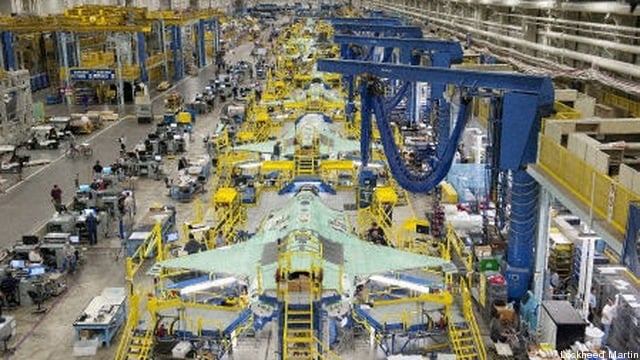Pentagon Trims Planned JSF Buy By 8; 60 Minutes’ F-35 Piece Not Bad
Posted on
WASHINGTON: Breaking Defense pretty much ignored the error-ridden piece that Vanity Fair ran about the F-35. We yawned when the Washington Post spent six months investigating the program and came up with a decent summary of the program and not much more.
So when 60 Minutes, still the biggest name in TV news, finally ran its piece on the F-35 (after six months of reporting, filming and editing) we had to take a peek, especially when a first look led me to conclude producer Mary Walsh and reporter David Martin had actually done their homework and gotten the basics right. They even broke a bit of news.
What was the news? They reported that the Marines received at least one F-35 with gaps in its critical stealth coating. Marine Lt. Gen. Robert Schmidle (that rara avis, a liberal arts graduate who has succeeded in the military’s upper reaches) got on the horn and told Lockheed Martin executives this was not acceptable and to fix it. He clearly put it in much more vibrant and direct fashion but was bashful about admitting it on camera. (After all, Marines never cuss…)
The sexiest portion of the 60 Minutes reporting was their coverage of the helmet. Breaking D readers won’t learn anything new, but the visuals are fun and Schmidle’s explanation of the targeting function is clear and useful. The description of the troubled ALIS software is useful. Schmidle makes the point simply. Lockheed and its subcontractors need to fix ALIS so pilots can override her when necessary.
The most surprising thing about the F-35 video was the complete absence of any of the plane’s critics. While avoiding Winslow Wheeler, Pierre Sprey and some others might be a fairly easy editorial decision, what about Sen. John McCain or perhaps Phil Coyle, the Pentagon’s former top tester. McCain seems to go hot and cold on the plane, so perhaps he wasn’t interested in speaking right now. Or perhaps he wasn’t approached. Coyle’s status as the former head tester would seem to make him an obvious choice. But there you go.
I’m not a TV critic, so I won’t blather on about how strong the stories’ visuals were or how tough Martin’s questioning appeared to be while on camera (after all, TV producers like Walsh are the main reporters for most stories). But I’ll give 60 Minutes credit for covering something they — and the rest of their ilk — should have been covering in much more depth and for much longer. After all, how to defend our country is the single largest spending decision an administration or Congress makes each year about the money taxpayers give the government. Then again. maybe we’re happy the major news shows, newspapers and such do such a spotty job…
One whom we can never accuse of spotty reporting is Tony Capaccio at Bloomberg. Tony reports the Pentagon budget better than anyone and he was fed the news that the upcoming budget will trim the planned purchase of F-35s by eight down to 34 from what was planned in the last budget.
Given that Air Force Chief of Staff Gen.Mark Welsh and Frank Kendall, undersecretary of Defense for acquisition, technology and logistics, had pledged to protect the plane in the budget, this looms later than it might otherwise.
Just six days ago, this is what Kendall said about the F-35 at the Singapore Air Show:
“You have to look at weapons on their value to the war fighter and a system like the F-35, which is a high-cost system comparatively, is a very high-value system,” he said. “The F-35 remains, despite its relatively high cost, a premier, number-one priority conventional warfare program for us, so we’re going to continue that under almost any budget level I would imagine that we would have to live with.”
Now trimming a purchase by eight planes from last year’s planned levels is not remarkable except when it’s such a tough budget time, the administration’s commitment to the aircraft is so robust and it’s, well, the most expensive conventional weapons system ever. Any appearance of a lack of American commitment to the plane, any sign that the politically sensitive cost per plane may increase and some of our European allies may back further away. And if they back away and buy fewer planes, then the costs per plane go up even more and the cycle can begin to turn into the dreaded death spiral.
Subscribe to our newsletter
Promotions, new products and sales. Directly to your inbox.

